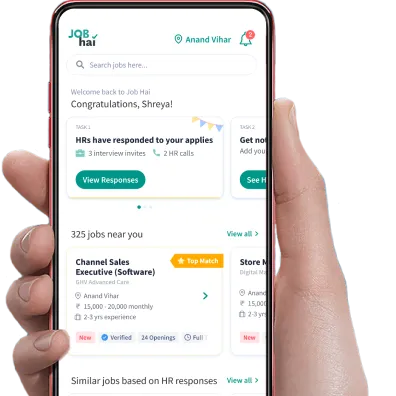ब्लिंकिट
ओखला, दिल्ली
Below 10th
New Job
99 ओपनिंग
Flexible Shift
0 - 6 months Experience in Delivery
Vignam Labs
घर से काम
Graduate
6 months - 3 years Experience in Manufacturing

₹40,000 - ₹60,000 /महीना *
अर्बन कंपनी
ओखला, दिल्ली
12th Pass
Incentives included
99 ओपनिंग
Day Shift
1 - 6 years Experience in Carpenter
Security Bazaar
ओखला, दिल्ली (फील्ड job)
10th Pass
Freshers in Security Guard
Jobs by Popular Companies in Okhla
J K Handwork
ओखला, दिल्ली
Below 10th
0 - 5 years Experience in Security Guard
Dilshad Traders
ओखला, दिल्ली
Below 10th
New Job
12 ओपनिंग
Day Shift
0 - 6 months Experience in Warehouse / Logistics
M J Traders
ओखला, दिल्ली
Below 10th
New Job
15 ओपनिंग
Day Shift
0 - 6 months Experience in Labour/Helper

₹25,000 - ₹55,000 /महीना *
Edylinn
ओखला, दिल्ली (फील्ड job)
Graduate
Incentives included
20 ओपनिंग
1 - 3 years Experience in Field Sales
Growth Hub Consultants
ओखला, दिल्ली (फील्ड job)
Graduate
1 - 3 years Experience in Field Sales
एचएसटी स्टाफिंग सोल्यूशंस
ओखला, दिल्ली
Graduate
2 - 5 years Experience in Graphic / Web Designer
बिग बास्केट
ओखला, दिल्ली (फील्ड job)
Below 10th
30 ओपनिंग
Rotational Shift
0 - 6+ years Experience in Delivery
Red Dash Media
ओखला, दिल्ली
Graduate
3 - 6+ years Experience in Sales / Business Development
Mavish Fashion
ओखला, दिल्ली
Graduate
3 - 6+ years Experience in Sales / Business Development
एचएसटी स्टाफिंग सोल्यूशंस
ओखला, दिल्ली
Graduate
2 - 5 years Experience in Painter
Ss Communication
ओखला, दिल्ली (फील्ड job)
Below 10th
0 - 6 months Experience in Delivery
Jobs by popular Localities around Okhla

₹25,000 - ₹40,000 /महीना *
Bridgeway Power Devices
ओखला, दिल्ली (फील्ड job)
10th Pass
Incentives included
5 ओपनिंग
2 - 4 years Experience in Sales / Business Development
Ahimsa Food
ओखला, दिल्ली
12th Pass
2 - 4 years Experience in Customer Support / TeleCaller
Lotus Petal Charitable Foundation
ओखला, दिल्ली
Below 10th
0 - 6 months Experience in Security Guard
Jobs by Popular Categories in Okhla
Shoora Financial
ओखला, दिल्ली
12th Pass
0 - 6+ years Experience in Back Office / Data Entry
Trumind Solutions
ओखला, दिल्ली
Graduate
3 - 6+ years Experience in Recruiter / HR / Admin
